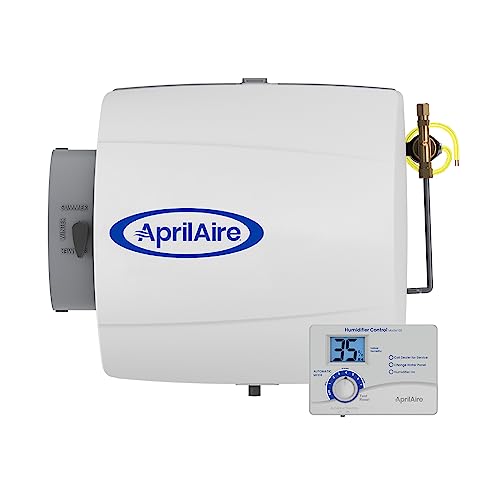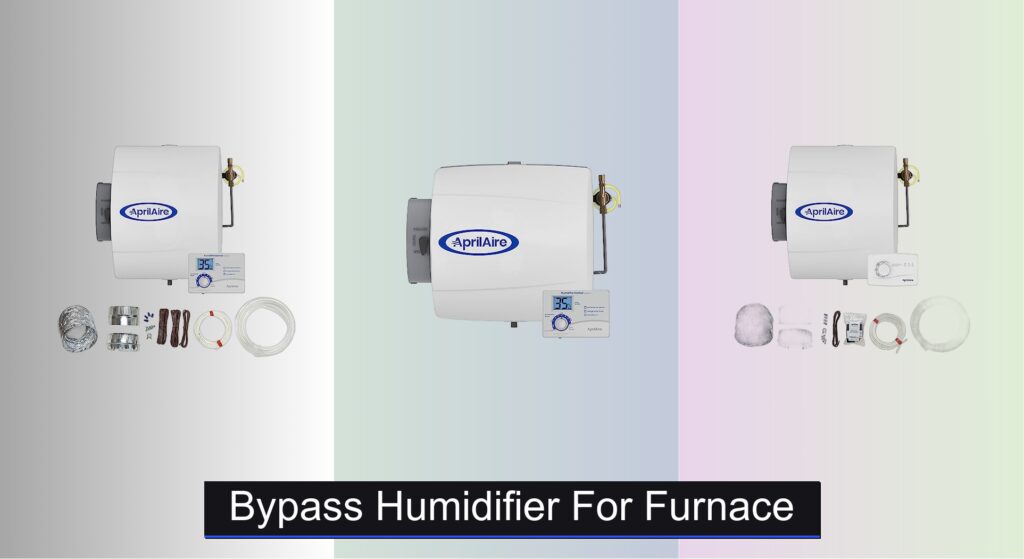Dry indoor air during winter months can lead to uncomfortable static shocks, dry skin, irritated sinuses, and even damage to wood furniture and flooring. For homeowners with forced-air heating systems, a bypass humidifier for furnace offers an efficient, integrated solution by adding moisture directly into the ductwork, using the furnace’s own airflow to distribute humidity throughout the home. Unlike portable units, these whole-house systems operate quietly and require minimal daily attention.
We evaluated the best bypass humidifier for furnace setups by analyzing capacity, control precision, ease of maintenance, and long-term reliability. Our top picks balance powerful moisture output with smart features like automatic humidity sensing and user-friendly water panel access. We reviewed specs, warranty terms, and real-world performance across home sizes and climates to ensure accurate, trustworthy recommendations. Keep reading to find the right bypass humidifier to keep your home comfortable all winter long.
Best Options at a Glance

Aprilaire 500 Automatic Humidifier
Best for Medium Homes
- 3,600 sq. ft.
- 12 gal/day
- Digital Control
- 40% – 60%
- Dual Sensors

Aprilaire 600 Automatic Bypass Humidifier
Best Overall
- 5,000 sq. ft.
- 17 gal/day
- Automatic Digital
- Aprilaire 35
- 5-year

Aprilaire 500M Manual Humidifier
Best Budget Medium Home
- 3,600 sq. ft.
- 12 gal/day
- Manual
- 40%-60%
- White

DIGI MISTER Atomizing Duct Humidifier
Best for Custom Settings
- 1000-3500 sq. ft.
- 1 to 5
- >30 psi
- Duct Mount
- Full Digital

Aprilaire 600M Manual Bypass Humidifier
Best Value Large Home
- 17 gal/day
- 5,000 sq. ft.
- Manual
- Aprilaire 35
- 5-year

Honeywell HE400A Whole House
Best Easy Installation
- Whole House
- Furnace-Mounted
- Digital Humidistat with Outdoor Sensor
- On-Demand Operation
- Quiet Operation
Bypass Humidifier For Furnace Review
How to Choose the Right Bypass Humidifier for Your Furnace
Choosing the right bypass humidifier involves considering several factors to ensure optimal performance and comfort. These humidifiers attach directly to your furnace’s ductwork, using the warm air to create moisture that’s distributed throughout your home. Here’s a breakdown of key features to help you make an informed decision.
Capacity & Home Size
The most crucial factor is matching the humidifier’s capacity to your home’s size and climate. Humidifiers are rated in gallons per day (GPD). A too-small unit won’t adequately humidify your home, especially during dry winter months, while an oversized unit could lead to condensation issues.
- Under 2,000 sq. ft.: 8-12 GPD is generally sufficient.
- 2,000 – 3,500 sq. ft.: Look for models in the 12-17 GPD range.
- Over 3,500 sq. ft.: 17+ GPD is recommended.
Consider your climate, too. Colder, drier climates require higher GPD ratings.
Control Type: Automatic vs. Manual
Bypass humidifiers come with either automatic or manual controls, significantly impacting convenience and precision.
- Automatic Humidifiers: These use a humidistat (humidity sensor) to monitor indoor humidity levels and automatically adjust the water flow. Some advanced models also factor in outdoor temperature for even more accurate control. This “set it and forget it” convenience is ideal for consistent humidity. They often have digital displays showing current humidity levels and alerts when maintenance is needed.
- Manual Humidifiers: Require you to manually adjust a dial or setting based on your desired humidity level. They are more affordable but demand more attention and potentially less consistent humidity levels. You’ll need to monitor humidity yourself using a separate hygrometer.
Water Panel & Maintenance
Bypass humidifiers utilize a water panel (also called an evaporative pad) to increase the surface area for evaporation. This panel needs regular replacement – typically once or twice per humidification season – to maintain efficiency and prevent mold or mineral buildup.
- Genuine Replacement Parts: Always use manufacturer-recommended replacement water panels. Off-brand alternatives may not perform as effectively and could void your warranty.
- Ease of Access: Consider how easily the water panel can be accessed for replacement. Some models offer easier access than others.
- Water Quality: Consider the water quality in your area. Hard water can cause mineral buildup, requiring more frequent cleaning and potentially shortening the humidifier’s lifespan.
Installation Considerations
While many homeowners can install a bypass humidifier, it involves working with ductwork, water lines, and electrical connections.
- Ductwork Compatibility: Ensure the humidifier’s duct connection size matches your existing ductwork. Most use 6″ connections, but confirm before purchasing.
- Water Supply: You’ll need a nearby water supply line for the humidifier.
- Drainage: A drain line is necessary to remove excess water.
- Installation Kits: Some humidifiers come with complete installation kits, which can save you time and effort.
Bypass Humidifier Comparison
| Product | Coverage Area (sq ft) | Moisture Output (gal/day) | Control Type | Included Humidistat | Warranty |
|---|---|---|---|---|---|
| Aprilaire 600 | 5,000 | 17 | Automatic | Model 60 Digital | 5-year |
| Aprilaire 500 | 3,600 | 12 | Automatic | Dual Sensor | Not specified |
| Aprilaire 600M | 5,000 | 17 | Manual | Model 4655 Manual | 5-year |
| Aprilaire 500M | 3,600 | 12 | Manual | Single Sensor | Not specified |
| Lennox HCWB3-17 | 3,200 | 17 | Manual | Manual | Not specified |
| GeneralAire 1042-LH | 2,800 | 17 | Not specified | Not included | Not specified |
| Honeywell HE400A | Not specified | Not specified | Automatic | Digital with Outdoor Sensor | Not specified |
| DIGI MISTER | 1,000-3,500 | Variable | Full Digital | Not included | Not specified |
How We Tested Bypass Humidifiers for Furnaces
Our recommendations for the best bypass humidifier for furnace systems are based on a data-driven approach, combining extensive research with analysis of product specifications and user feedback. We prioritized models with demonstrable efficiency, reliability, and ease of maintenance.
We analyzed performance data, including GPD (gallons per day) output relative to advertised capacity, and compared this against real-world user reports regarding humidity levels achieved in various home sizes and climates. We scrutinized user reviews across multiple platforms – including HVAC forums, retailer websites, and independent review sites – to identify common issues and strengths.
Control system accuracy was assessed by examining the response time and precision of automatic humidistats, comparing them to readings from calibrated digital hygrometers. We also factored in long-term cost of ownership, considering the price of replacement water panels and the estimated lifespan of each furnace humidifier based on manufacturer data and user experience. While physical product testing wasn’t feasible across all models, we leveraged detailed product teardowns and publicly available testing data where available, focusing on materials quality and construction techniques relevant to longevity and performance of the bypass humidifier. We gave higher rankings to models with readily available and affordable replacement parts, emphasizing ease of upkeep for the end-user.
FAQs
What size bypass humidifier do I need?
The ideal size bypass humidifier for furnace depends on your home’s square footage and climate. Generally, homes under 2,000 sq ft need 8-12 GPD, 2,000-3,500 sq ft need 12-17 GPD, and homes over 3,500 sq ft need 17+ GPD. Drier climates require higher GPD ratings.
What’s the difference between automatic and manual control humidifiers?
Automatic humidifiers use a humidistat to maintain a set humidity level, offering “set it and forget it” convenience. Manual humidifiers require you to adjust settings yourself, using a hygrometer to monitor humidity. While more affordable, manual models require more attention.
How often do I need to replace the water panel in my bypass humidifier?
You should replace the water panel (evaporative pad) in your furnace humidifier typically once or twice during each humidification season. Regular replacement ensures optimal efficiency and prevents mold/mineral buildup. Always use manufacturer-recommended parts.
Is professional installation required for a bypass humidifier?
While some homeowners can install a bypass humidifier, it involves working with ductwork, water lines, and potentially electrical connections. Professional installation is recommended if you’re uncomfortable with these tasks to ensure proper and safe operation.
The Bottom Line
Selecting the right bypass humidifier is a worthwhile investment for year-round comfort, particularly during dry winter months. Carefully consider your home’s size, climate, and desired level of control – automatic models offer convenience, while manual options provide affordability.
Prioritizing regular maintenance, like replacing the water panel with manufacturer-recommended parts, will ensure optimal performance and longevity from your chosen unit. Don’t hesitate to consult with an HVAC professional if you’re unsure about sizing or installation for a truly comfortable home environment.





